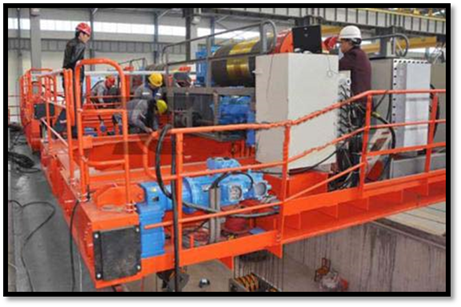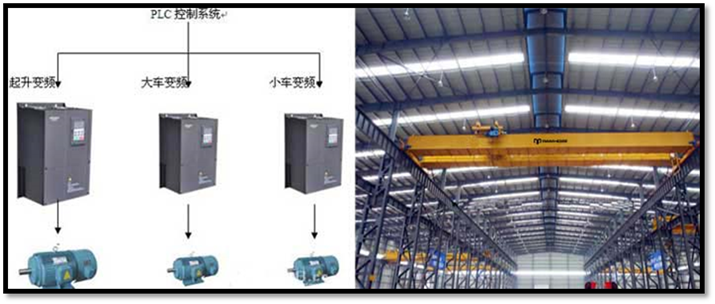
Variable Frequency Crane characteristics and principles
Keyword:Variable Frequency Crane Time:2018-12-2 9:33:35
Variable Frequency Crane introduction
For crane equipment, the variable frequency crane with variable frequency drives for cranes can improve the speed control performance by improving the performance of the crane motor, which is made on the basis of the traditional crane. This kind of motor can greatly improve its speed governing performance, which is frequency conversion crane.

Variable Frequency Crane origin
With the development of the times and the progress of technology, people's requirements for cranes in production operations have been constantly improved, such as speed adjustment ability.
It is necessary to configure the electric rotor and brush on the asynchronous motor around the rotor, and can use a large number of relays and contactors to accelerate the speed. This is the characteristic of the traditional crane motor. But the disadvantage of this speed regulation method is that the collector ring and brush must be kept regular and prone to failure. This is a great drawback to it. Due to the large amount of components used, the workload of on-site maintenance is large. The overall performance of the speed control system is poor. Nowadays, traditional speed control cranes can no longer satisfy some applications with high speed control performance requirements.
With the development of AC variable frequency speed regulation technology, new solutions have been brought to these problems, and their applications are becoming more and more extensive. The application of AC variable frequency speed control technology in the cage asynchronous motor makes the motor work better speed control performance. This application is simple, reliable and convenient to repair. Variable frequency crane also called VFD crane can greatly improve the speed governing performance of crane equipment.
Variable Frequency Crane Characteristics
First of all, the variable frequency crane is very flexible in controlling the starting plate. It can be started steadily from 0Hz to 50Hz. It can set acceleration time and control the speed of operation more accurately.
Secondly, it adopts the deceleration stop and acceleration mode, which makes the start and stop running smoothly. The influence of the crane brake, the reducer, the wire rope and other force components is greatly reduced, and the service life of the machine can be extended.
Third, reduce power waste and achieve energy saving. When the inverter crane starts, the current will not increase sharply, and the influence of the current on the power grid will be greatly reduced.
Fourth, make the lifting mechanism of the crane run smoothly. This is because the benefits of setting up a vector inverter on the main hook are good.
Introduction of frequency converter function and classification
The electrical equipment that converts the power frequency to any frequency and any voltage AC power is called an inverter. In order to adjust the power of the motor, we use the frequency converter to achieve the speed of motor. Frequency converter has good performance, especially for crane and hoist frequency convert.
The control circuit and main circuit are primary components of the inverter, and the main circuit is composed of rectifier and inverter.

Inverter Working Principle of Variable Frequency Crane
Controlling the main circuit through the control circuit is the main principle of the inverter, which converts AC to DC through the rectifier in the main circuit, the DC intermediate circuit will be smooth and the inverter will be converted into DC. The DC current needs the frequency and voltage for the AC, and some inverters are added to the components such as circuit CPU to carry out the necessary torque operation.
The birth of the inverter is required by the stepless speed regulation on the AC motor, with thyristor, electrostatic induction transistor, high voltage insulated gate bipolar thyristor and so on. Electrical technology and frequency conversion technology is changing with each passing day. With the development of dedicated PWM VVVF technology, frequency converter has reached a new level. Frequency converters are widely used in many aspects, such as lifting, handling, pitching, handcart, slewing and other lifting appliances.
Inverter Classification
50Hz or 60Hz is the general frequency of the inverter in the household or production field, and the power frequency and power are maintained in this value. The cause of power failure is because the power is too fast in the power motor, so the speed of the power loss can be reduced by adjusting the inverter.
It is divided into general frequency converter, high performance special frequency converter, high frequency inverter, single-phase inverter and three-phase inverter, which can be divided into V/F control inverter, inverter frequency control inverter and vector control inverter according to the working principle of frequency converter.
Frequency inverter characteristics
DC exciter
Low frequency with high starting torque
Motor parameters self-tuning
Multiple motors switching
Reliable brake control
Synchronous speed
Power equalization
Professional network communication
Please contact RAMHOIST if you have any futher question for Variable Frequency Crane.

- No information
-
1. Design objective of electronic crane scale network management. (1) Adopt advanced distributed data processing techno…
-
Electronic crane scale bearing platform installation to focus Electronic crane scale can be installed generally on the li…


